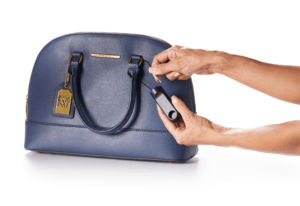Beyond the Magnet: The Pitfalls of Magnetic Security Tags and Reliable Alternatives

The prevalence of magnetic security tags is evident, yet so are the resources detailing their defeat. From YouTube videos and WikiHow tutorials (we certainly won’t share here), to Amazon listings for magnet detachers, the coexistence of these sources underscores a troubling reality. Although retailers have used magnetic tags for decades to deter theft, they’re easy to defeat and downright unreliable. Read more, to find out why you need more reliable security.

Key Takeaways:
1. Learn about the types of magnetic tags and how they work.
3. The pitfalls of using magnetic tags and why your merchandise may not be protected.
2. Discover more reliable security tags for packaged and sell-thru merchandise with InVue.
The science of magnetic retail security tags
Primarily used as tags for apparel, eyewear, shoes, accessories, and even liquor bottles, they are favored by many stores due to their relatively low cost. Magnetic tags are classified by the strength of the magnet (standard, super-strength, hyper-strength, and multi-polar). The stronger the magnet, the more difficult it should be to remove.
In simple terms, magnetic tags have two magnetic strips inside of a plastic case with a pin in between to connect the two sides of the tag and secure it in place. The effectiveness of these tags heavily relies on the strength of the locking mechanism, and the size of the plastic housing. You push the side of the tag with the pin through the merchandise to connect it to the other side of the tag and secure it in place. A store will have either an Electronic Article Surveillance (EAS) or Acousto Magnetic (AM) detector placed near the exit, and when a magnetized tag passes close to the sensor detector, the magnets inside will oscillate creating a frequency that’s transmitted to the sensor, thus emitting an alarm to notify staff when products are leaving the store unauthorized.
The negatives of using magnetic tags
1. Easily removed
When you take your tagged item to checkout, the associate will remove the tag by placing it on a high-powered magnet to demagnetize it and pull it apart. Since all you need is just a stronger magnet (typically made of neodymium), they’re very easy to defeat. A quick online search will lead you to various retailers where you can purchase your own more powerful magnet for the job. Even without this, they can be defeated or broken using brute force, a Dremel tool and needle nose pliers, or even rubber bands.
2. Mainly used as a visual deterrent vs a reliable form of security

How many times have you heard a store’s alarm going off and just assumed it was because the associate forgot to remove a security tag? You probably felt it was more of an annoyance as opposed to being worried about someone actually shoplifting. Well, you’re not alone. Magnetic tags are more of a visual deterrent against retail theft than anything else since they’re known for triggering false alarms.
There’s plenty of instances where someone genuinely forgot to remove the tag and the customer only notices days later. Instead of returning to the store, a simple Google search will show you multiple ways to remove it right at home with items you’ll readily have available. With enough time or the right tools, a thief can pop them off effortlessly right in-store or trigger the alarm and remove the tags later at home. Magnetic tags are so commonplace that many shoppers have become desensitized to the sound of the alarm.
3. Not compatible with all merchandise
Because hard tags require pins to adhere to products, they can’t be used on many items without a flat surface. Additionally, they aren’t visually appealing and require punching holes in the product, which isn’t ideal for high-value goods like luxury apparel and handbags, or items with a unique shape.
Invest in reliable security that can’t be defeated by magnets
At InVue, our security solutions for packaged and sell-thru goods rely on our patented IR OneKEY technology for access, meaning they can’t be defeated by a strong magnet. Click below to check out robust and reliable upgrades to traditional magnetic and ink tags:
 |
Cable Lock: InVue’s Cable Lock is the only soft goods tag that can’t be detached using a magnet. It is perfect for use as clothing tags and for high-end goods because it doesn’t require a pin to close. The wire can loop onto a part of the merchandise without damaging it. |
 |
NEW Cable Lock Anchor: The Cable Lock Anchor is a double-sided cable lock that adheres to the product and a fixture for added security. The locks work with an EAS system and feature a coiled cable that allows customers to freely interact with the product without triggering false alarms. |
 |
Package Wrap: Protect packaged products with InVue’s Package Wrap. The spider wrap design consists of steel cables and a 2-alarm system that provide a snug fit around merchandise and cannot be easily cut or deactivated using a magnet. |
 |
OneKEY Bottle Cap: Protect the most stolen grocery item with a bottle cap that requires our patented IR OneKEY to open. |
In a nutshell, magnetic tags might seem like a quick fix, but they’re easily bypassed by common magnets or basic tools. They’re more of a visual deterrent than a reliable security measure and can be a hassle for both customers and staff with their frequent false alarms. Instead, consider upgrading to InVue’s range of innovative solutions like the Cable Lock, Cable Lock Anchor, Package Wrap, and OneKEY Bottle Cap for foolproof protection. It’s a smart move to keep your merchandise safe and your business running smoothly.

